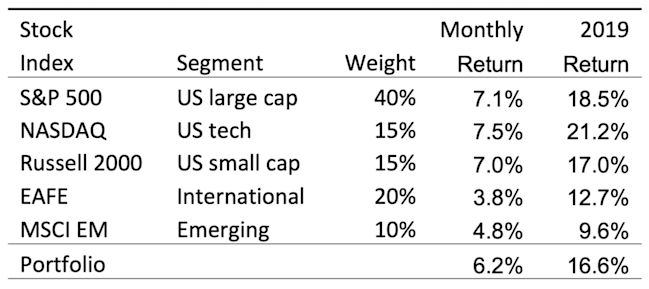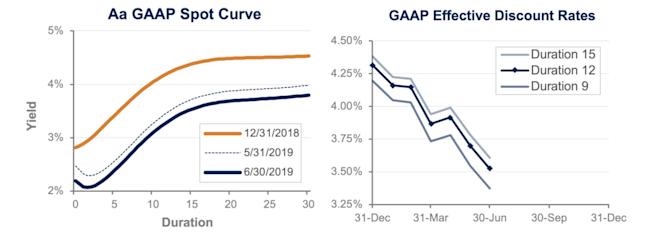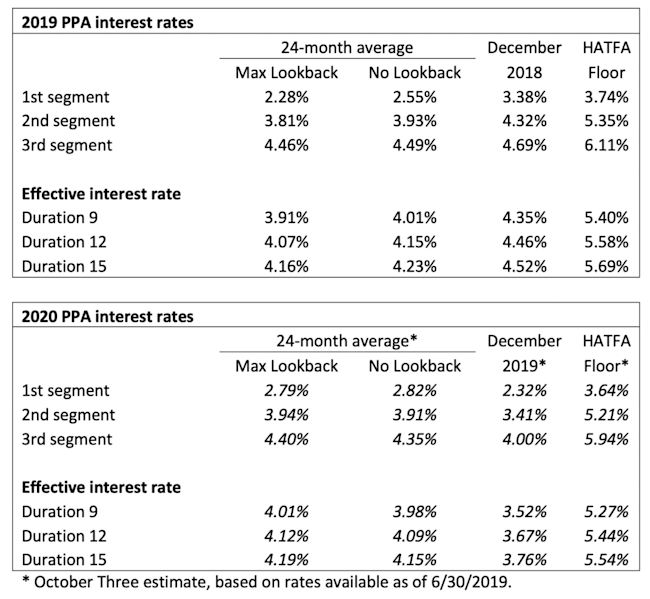June 2019 Pension Finance Update
Pension finances improved in June, as stock market gains overcame lower interest rates. Both model plans we track[1] gained ground last month: Plan A improved close to 2%, ending the first half of 2019 basically flat, while Plan B added close to 1% and is now up less than 1% through the first six months of 2019.
Pension finances improved in June, as stock market gains overcame lower interest rates. Both model plans we track[1] gained ground last month: Plan A improved close to 2%, ending the first half of 2019 basically flat, while Plan B added close to 1% and is now up less than 1% through the first six months of 2019:

Assets
Stocks recouped most of May’s losses in June, gaining 4%-7% for the month and cementing a strong first half for 2019. The table below summarizes returns on various stock indexes included in our model portfolio:

Bonds added 1%-2% during June, as Treasury yields dropped almost 0.1% and corporate bond yields fell almost 0.2%. For the year, bonds have earned 8%-10%, with long duration and corporate bonds performing best.
Overall, our traditional 60/40 portfolio gained 4% in June, ending the first half of 2019 up more than 12%, while the conservative 20/80 portfolio gained more than 2% last month and is up more than 10% during 2019.
Liabilities
Pension liabilities (for funding, accounting, and de-risking purposes) are driven by market interest rates. The graph on the left compares our Aa GAAP spot yield curve at December 31, 2018, and June 30, 2019, and it also shows the movement in the curve last month. The graph on the right shows our estimate of movements in effective GAAP discount rates for pension obligations of various duration during 2019:

Corporate bond yields, which have moved remorselessly lower this year, fell another 0.2% in June, increasing pension liabilities 2%-3%. For the year, liabilities are now up 10%-15%, with long duration plans seeing the largest increases.
Summary
Legendary investor Yogi Berra once quipped: “It’s tough to make predictions, especially about the future.” At the beginning of the year, almost no one foresaw corporate bond yields falling 0.75% or stock markets earning 15%+ in the first half of the year, but here we are. As dramatic as these movements have been, the upshot for pensions has been basically a wash. The graphs below show the progress of assets and liabilities for our two model plans through the first half of 2019:

Looking Ahead
Pension funding relief has reduced required plan funding since 2012, but under current law, this relief will gradually sunset by 2023, increasing funding requirements for pension sponsors that have only made required contributions.
Discount rates fell close to another 0.20% last month and are now flirting with all-time low rates for the fifth time this decade. We expect most pension sponsors will use effective discount rates in the 3.2%-3.7% range to measure pension liabilities right now.
The table below summarizes rates that plan sponsors are required to use for IRS funding purposes for 2019, along with estimates for 2020. Pre-relief, both 24-month averages and December ‘spot’ rates, which are still required for some calculations, such as PBGC premiums, are also included.

[1]Plan A is a traditional plan (duration 12 at 5.5%) with a 60/40 asset allocation, while Plan B is a largely retired plan (duration 9 at 5.5%) with a 20/80 allocation with a greater emphasis on corporate and long-duration bonds. We assume overhead expenses of 1% of plan assets per year, and we assume the plans are 100% funded at the beginning of the year and ignore benefit accruals, contributions, and benefit payments in order to isolate the financial performance of plan assets versus liabilities.
